The Razer Blade Stealth Review: Razer Takes On The Ultrabook
by Brett Howse on March 29, 2016 8:00 AM EST- Posted in
- Laptops
- Razer
- Skylake
- Razer Blade Stealth
- eGFX
- Razer Core
- Skylake-U
GPU Performance
The Core i7-6500U features an Intel HD 520 graphics processor, which is a 24 execution unit (EU) configuration of Intel’s Gen 9 graphics. Intel has been focusing on graphics performance quite a bit over the last several generations, and the integrated solutions are now fairly capable. Intel also has the Iris graphics, which is a 48 EU version of this GPU and it also includes eDRAM. With Razer’s gaming pedigree it would have been nice to see this as an option on the higher model unit, but likely due to pricing and availability of the Iris parts, they have elected to stick with the standard Ultrabook part, and supplement it with an optional external graphics dock in the Razer Core. As much as this isn’t a gaming device, the addition of Iris graphics would likely have a significant impact on its capabilities, but for normal desktop tasks and light gaming, the HD 520 should do the trick.
3DMark
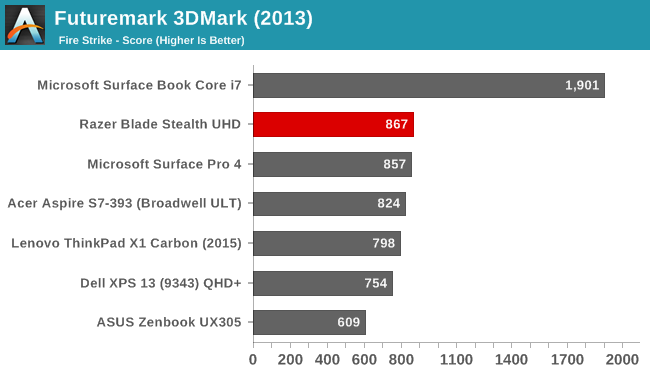
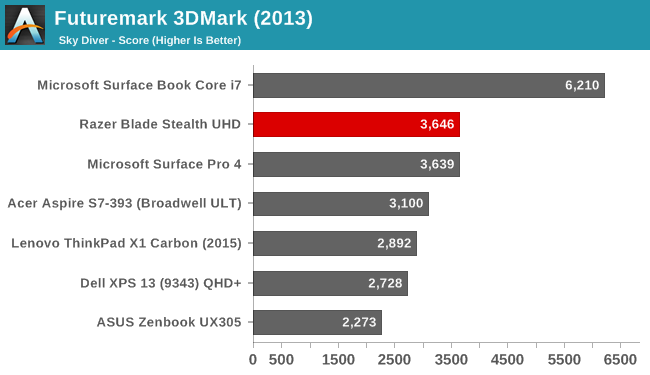
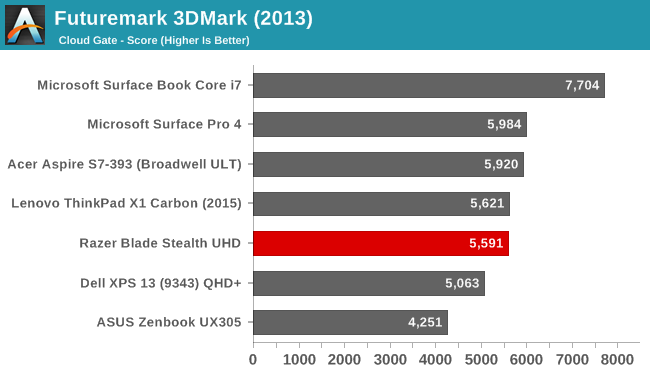

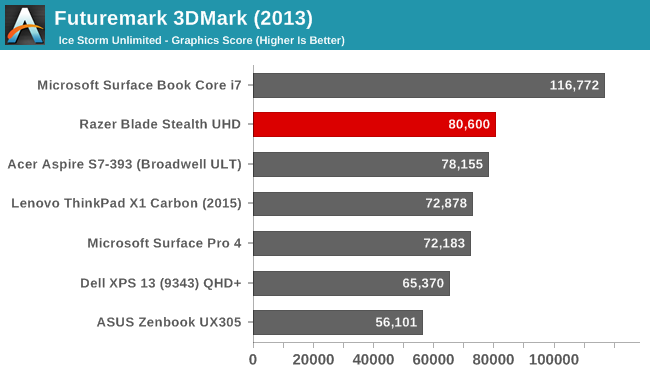
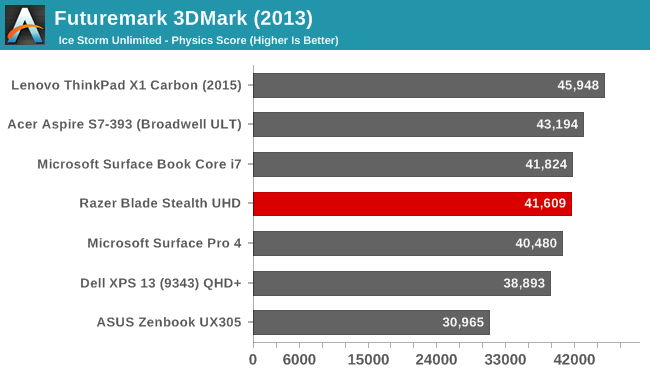
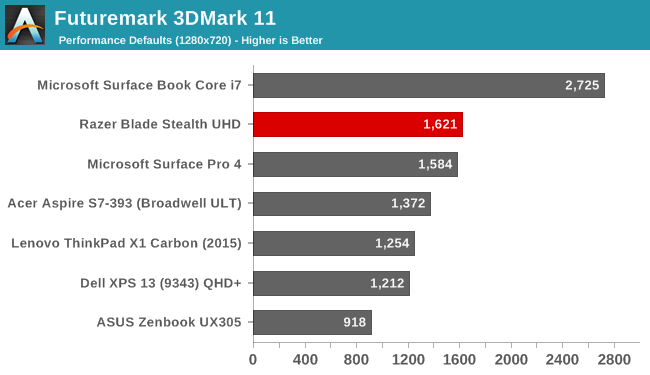
Futuremark’s 3DMark features a set of tests which ramp up in difficultly from Ice Storm Unlimited, which is basically a smartphone class test, up to Fire Strike which can be punishing even on laptops with high end GPUs. The Razer Blade Stealth falls in line with the other systems that leverage HD 520 graphics, but is a long way off of the Surface Book Core i7 with its GT 940M graphics card.
GFXBench
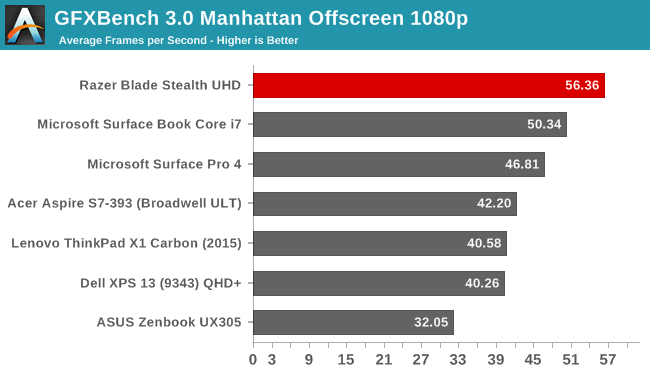
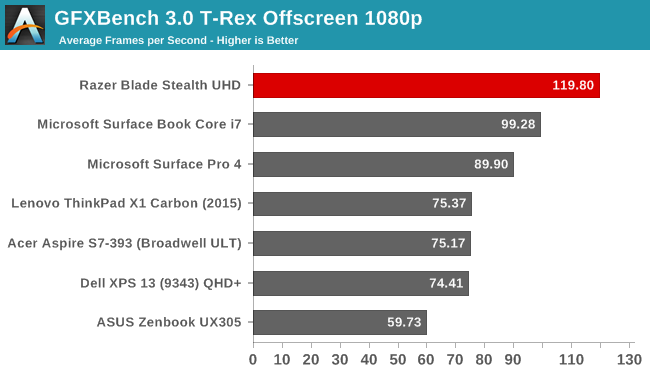
GFXBench has been updated to version 4 on Windows, giving us some new tests to work with. Once we have enough results for a comparison, the new tests will be included as well, but for now we can look at Manhattan and T-Rex. T-Rex is quite a bit lighter of a workload, and the Stealth has no issues running it at 1080p, and the results on Manhattan are decent as well.
Dota 2



Valve’s free to play online multiplayer arena game is a light enough test that it is suitable for devices with integrated graphics. Running at the maximum settings at 1080p can still be a bit too demanding, but our test run on this game is a very difficult section for the GPU so these results should be near the worst case for the graphics processor. Once again the Stealth is no match for the discrete graphics in the Surface Book Core i7, but it holds its own against the other integrated solutions. It would be really interesting to see this with Iris graphics though, but that will have to be another day.
Graphics Conclusion
The Razer Blade Stealth is not a gaming laptop, despite it being sold by a company that has focused on gaming for its entire existence. That is a bit odd, to be honest, but I can see where they were going on price and accept the choice of processor on that basis. The Core i7 version of the HD 520 has a slightly higher frequency on the GPU, which adds a tiny bit more performance over the Core i5, and of course anything that is getting to be CPU limited will struggle less with the i7, but overall the results are pretty much in-line with the other integrated solutions that we’ve tested.
Storage
The age of PCIe based storage is definitely upon us, with most of the new products this year featuring PCIe 3.0 x4 NVMe solutions, and Razer is no exception. They, like most OEMs this year, have gone with the Samsung PM951 as the drive of choice. This is a TLC based drive, and it tends to suffer on write speeds compared to the MLC SM951 version. Read speeds, especially sequential, are very good though. Hopefully we’ll start to see this supplanted by the PM961 which was just announced and which promises better performance, but it would seem Samsung has the lion’s share of the OEM drive market with the PM951.
Razer sent us both the QHD version with a 256 GB drive and the UHD version with the 512 GB drive, so we can see how much the added NAND parallelization adds to the performance.
The 512 GB model has enough NAND that the write speeds are still very good, but you can see the 256 GB version is quite a bit slower, not that 300 MB/s is really slow, but compared to the performance of the MLC version, it is down quite a bit. The 128 GB model is going to likely be closer to 150 MB/s, which is getting into desktop hard drive speeds. It’s great to see the move to PCIe storage, but unfortunately for now everyone seems to be using the TLC drive from Samsung.



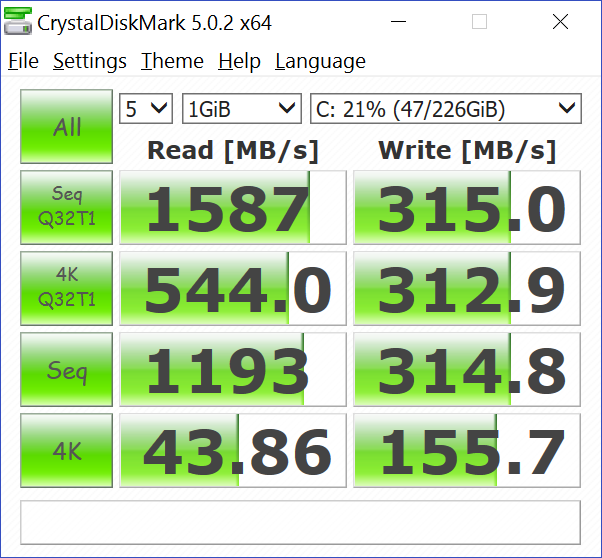








66 Comments
View All Comments
nerd1 - Tuesday, March 29, 2016 - link
Xps13 can be bought around 799 nowadaysBrokenCrayons - Tuesday, March 29, 2016 - link
“For Gamers. By Gamers.”Interplay, is that you in there? What happened to Van Buren?
retrospooty - Tuesday, March 29, 2016 - link
I never really got the need for a "gaming notebook". Gaming is far better, faster and cheaper on a desktop. Do alot of people really have the need to game when mobile? I would personally think most people, when out and about are doing whatever task they are out and about for, not worrying about gaming until they get home and have time for it. Is it just me? I guess if you travelled for work alot and wound up with extra time, but that screams niche market.BrokenCrayons - Tuesday, March 29, 2016 - link
Most mobile gaming I see happens on a phone and not on a laptop. There are most certainly a lot of people who spend time away from home due to work that might benefit from a gaming laptop, but this particular laptop isn't a gaming box without the not-so-mobile Razer Core and other external bits like a monitor, full sized keyboard, and mouse. The benefit in this to those sorts of people is that they only need to worry about one computer as opposed to a laptop and desktop. The Stealth's potential of using an external, desktop GPU offers some flexibility at an added cost. So yes, there's a point and yes its a niche market.The "but" in all of this is that the niche market might be larger than you think. People with no legitimate need for the capabilities the Stealth + Razer Core offers might still purchase such a setup or some other gaming laptop in order to have those capabilities. The expense could very well do nothing but address a psychological need that exists without reason purely inside the mind of the buyer. It happens pretty frequently in automotive markets where people buy much more capability than they need in order to be prepared to drive in weather or road conditions that happen for merely a day or two out of the year. They then willingly endure the liability of their purchase the other 363 days happily. Similarly a person with no need for a gaming laptop will be able to play games in a hotel room for a couple of days a year and deal with the cost and performance penalty of their purchase the rest of the time for little to no rational reason.
TheinsanegamerN - Tuesday, March 29, 2016 - link
There are people like me, that have LAN gaming parties. A laptop is so much more convenient. And I can play it at the laundromat when Im doing my laundry every weekend.I also live in a 1BD apartment. Space is at a premium, there is nowhere to put a nice computer desk for a desktop.
nerd1 - Tuesday, March 29, 2016 - link
Laptop is more convenient but you cannot play any real game on this laptop.BrokenCrayons - Wednesday, March 30, 2016 - link
I never understood what makes something "real" or not. Even a nearly ten year old GMA 950 can run games, some of which were flagship releases in the past. Does the age of a game make it lose it's connection with reality? Is something only "real" if it's been released in the last few months because humans can't fathom the relationship of the past to the present?DarkXale - Wednesday, April 6, 2016 - link
Depends on the definition of real.CS? It can handle.
LoL? It can handle.
DOTA2? It can handle. (Even benchmarked here at +60FPS)
WoW? It can handle.
Civilization 5/BE? It can handle.
Football Manager? It can handle.
Rocket League? It can handle.
You'd probably want to stay clear of Battlefield 4 or Witcher 3 - but at this point we're talking exceptions, not a norm.
DarkXale - Wednesday, April 6, 2016 - link
I should point out that I chose these titles since they're generally where you tend to see the most /played being done -today-.rxzlmn - Tuesday, March 29, 2016 - link
I don't think it's that uncommon for people to have jobs which require a decent amount of travelling. The main point is that it's easily transported from A to B, not that you can use it for gaming on the route itself. If you move, especially internationally, it makes sense. If you don't have a lot of space, it makes sense. If you want to have one main computer for both work and gaming, it makes sense (as a computer for work often has to be portable, i.e. bringing it to work places, meetings, on the plane, etc).I have a solid notebook that also happens to be powerful enough to run games, and nowadays the mobile GPU/CPUs are fast enough to run most games properly. Of course not with all the bells and whistles, but I can play most stuff on full HD and somewhat medium settings just fine, and my laptop only has a midrange mobile GPU.
Apart from myself opting for all the above mentioned benefits, I would also have to spend considerably more for a gaming capable desktop and a comparable non-gaming capable laptop together.